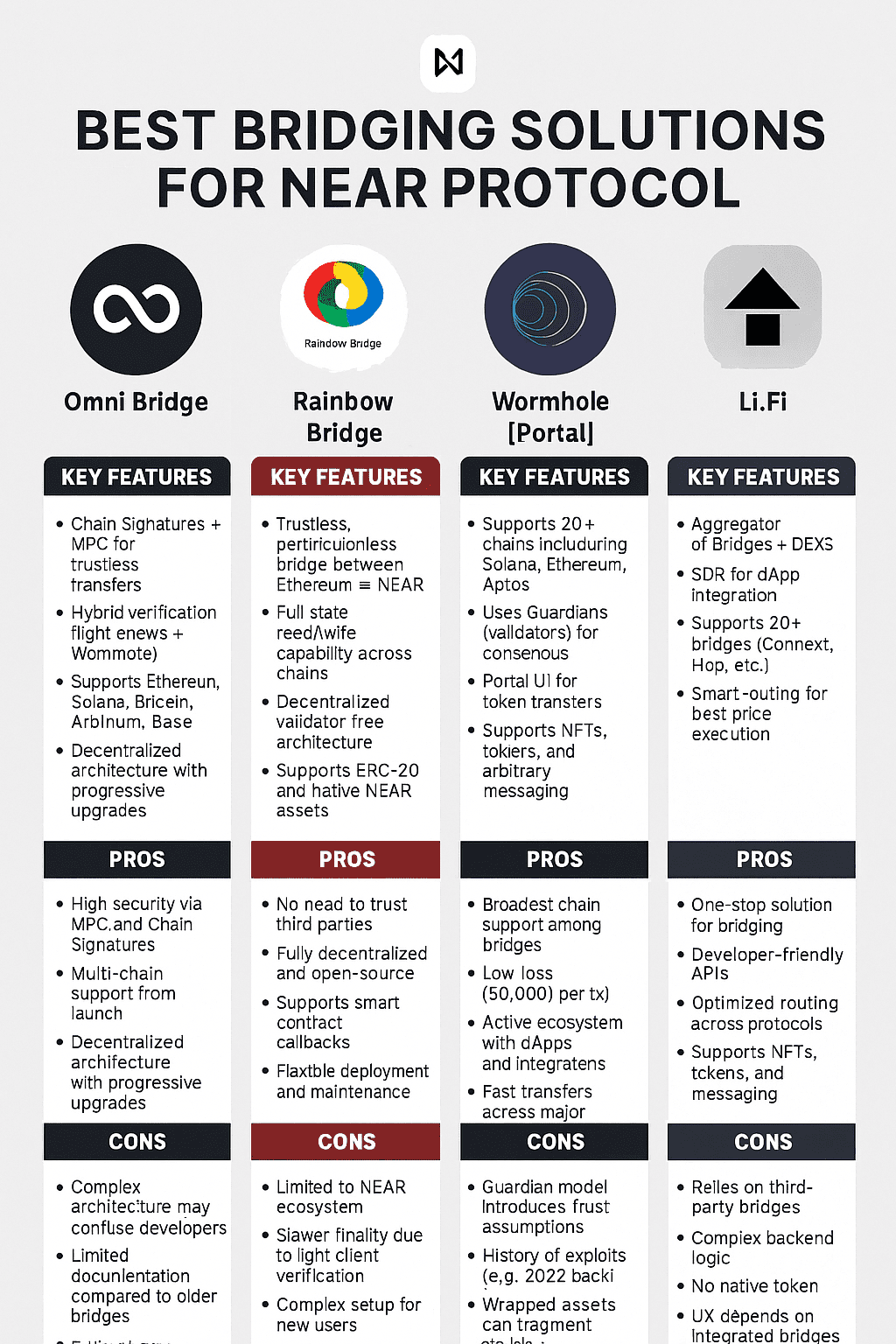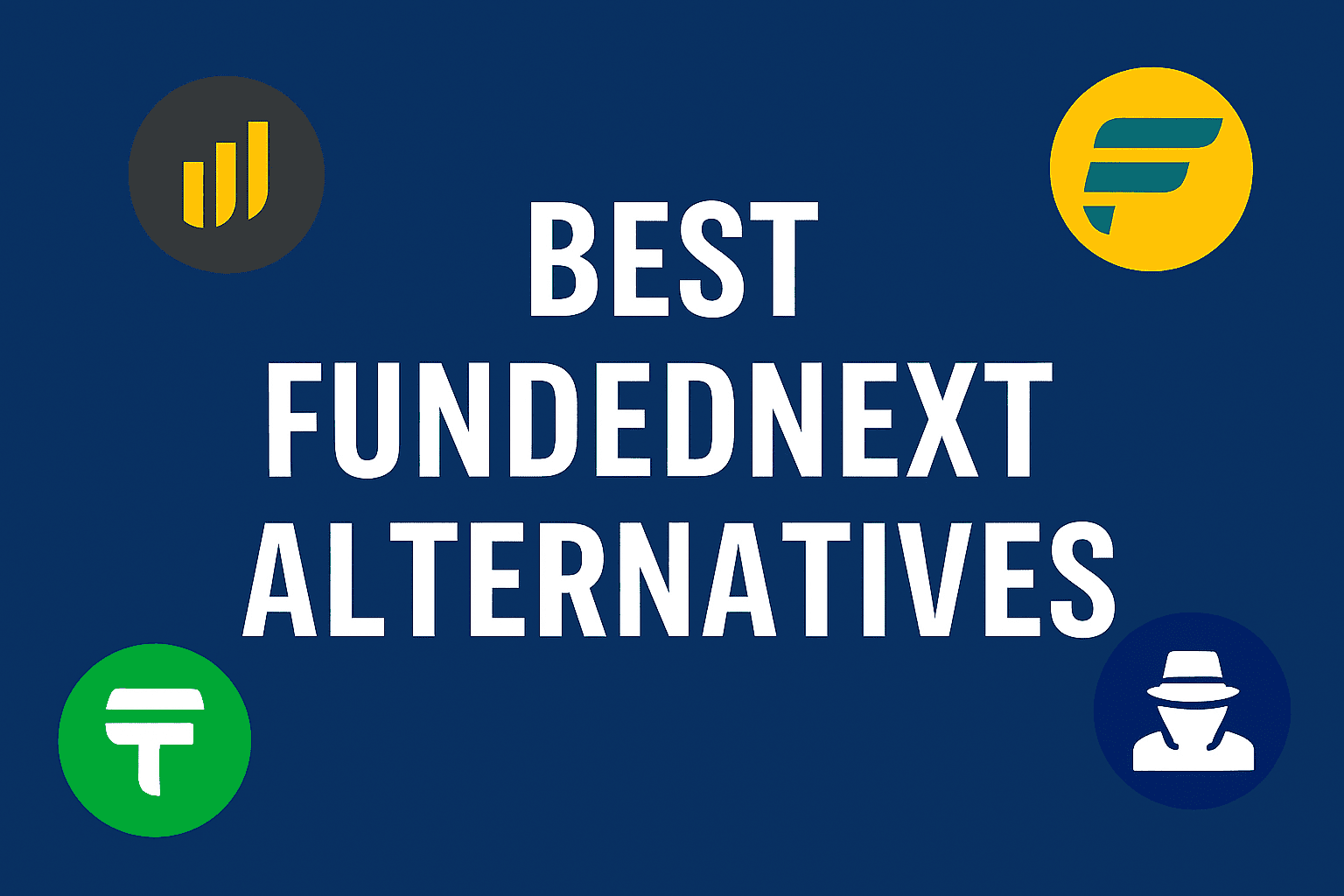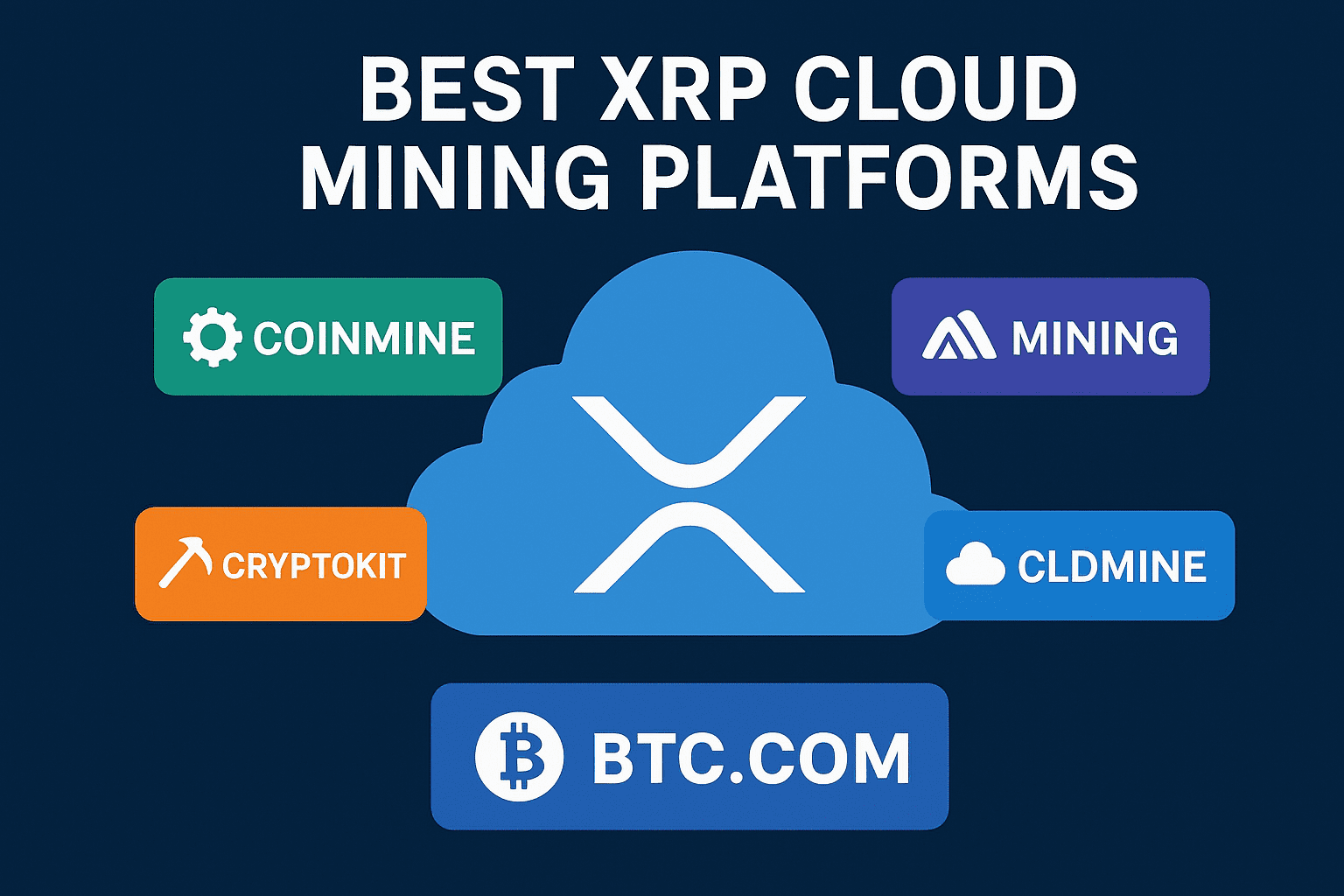With the blockchain ecosystem increasingly interconnected, Near Protocol is recognized for its speed, scalability, and ease of use for developers. However, Near users need effective bridging solutions for cross-chain connectivity and interoperability and for working with Near’s Ethereum, Solana, and BNB Chain ecosystems.
The best bridges for Near make it possible to transfer Near assets, use Near for cross-chain liquidity, and enable Near’s attributable ecosystems connectivity, opening the DeFi and Web3 ecosystems and applications to users.
What is Bridging Solutions?
Bridging solutions are technologies that facilitate the movement of digital assets, information, or messages across different, isolated blockchain technologies. Since most blockchains work independently with unique protocols and tokens, bridge technologies serve as connectors that enable users and developers to transfer blockchains like Ethereum, Near Protocol, and Solana.
These solutions help counter the problem of blockchain fragmentation, unlocking true interoperability. Bridging technologies enable decentralized applications (dApps) to tap into liquidity and users from multiple blockchains.
Bridging technologies enhance the scalability, accessibility, and cross-chain innovation of the Web3 ecosystem. In essence, bridging solutions enhance communication across blockchain networks, permitting the secure transfer of assets between chains.
How To Choose the Best Bridging Solutions For Near Protocol?
Security and Trust
When choosing a bridge, look for ones that provide comprehensive security audits and have transparent and hack-free validators. For Near Protocol, or “native” Near options, “Rainbow Bridge” provides the best decentralization and assures trustless transfers. Safe user asset storage is guaranteed and trust is well-placed.
Network Compatibility
If you are undertaking cross-chain operations, pick a bridge that is networked with multiple blockchains. Multi-chain bridges that link Near, Ethereum, Solana, and other major ecosystems like Wormhole, Axelar, or LI.FI provide cross-chain transfers that favorable interoperability.
Transaction Speed and Cost
Select bridges with quick confirmations and cheaper/more affordable gas fees. Stargate and Connext excel in quick transfers because they instantaneously finalize and cross-chain swaps are economically pod for traders and active DeFi users.
Developer Integration
For the developers, trying to build cross-chain dApps, adopting Axelar, Synapse, and deBridge is valuable for creating seamless integration with sophisticated messaging, cross network, and on-chain communication scope, and consolidation for scalable systemic cross-chain dApps.
Liquidity and User Experience
Look for bridges with lots of easy to use deep liquidity and simple interfaces for efficient transfers. Symbiosis and LI.FI are relaxing to use as they abstract more than five sources of liquidity and provide one-click cross-chain swaps, which is wonderful because it saves time. These systems are user-friendly and provide cross-chain transfers for any scope of experience.
Ecosystem Reputation
When selecting bridges, pick those that people know well and that are integrated well within the entire Web3 ecosystem. The Rainbow Bridge, Wormhole, and Axelar have good reputations and big developer communities that provide continuous improvements to the reliability, security, and sustainability over long periods for Near users.
Key Point
| Bridge Name | Main Function / Description | Key Advantage for Near Protocol |
|---|---|---|
| Omni Bridge | A universal bridge connecting Ethereum-based tokens and data with Near and other EVM chains. | Fast, reliable, and highly compatible with EVM assets. |
| Rainbow Bridge | The official Near-Ethereum bridge enabling trustless, permissionless transfers of tokens and NFTs. | Fully decentralized, low fees, and native to Near Protocol. |
| Wormhole (Portal) | A leading cross-chain messaging and asset transfer protocol linking major L1 and L2 blockchains. | Multi-asset support with institutional-grade security. |
| Stargate | A cross-chain liquidity bridge built on LayerZero enabling instant stablecoin swaps across chains. | Instant finality and unified liquidity for seamless transfers. |
| Synapse | Cross-chain AMM bridge offering token swaps and messaging between multiple ecosystems. | Secure, fast, and offers low-slippage cross-chain liquidity. |
| Symbiosis | A multi-chain DEX and liquidity protocol enabling one-click cross-chain swaps. | User-friendly interface with unified liquidity aggregation. |
| deBridge | Decentralized interoperability protocol enabling secure asset and data transfers across chains. | Enterprise-grade security and flexible integration options. |
| LI.FI | Aggregates multiple bridges and DEXs for optimized cross-chain routing. | Smart routing for best transaction speed and cost efficiency. |
| Axelar | Decentralized interoperability network for cross-chain communication and token movement. | Developer-friendly APIs and robust decentralized infrastructure. |
| Connext | Modular protocol enabling trust-minimized cross-chain transfers and contract calls. | Low-cost, fast, and highly flexible for dApp developers. |
1. Omni Bridge
The Omni Bridge is a cross-chain protocol primarily built on the Ethereum ecosystem. Designed for hassle-free token and data cross transfers, it grows to include Near Protocol as well. It serves as a universal bridge to enable smart contract driven asset transfers to and from Near and Ethereum compatible blockchains.

For DeFi developers, it is invaluable for quick and secure access to Near’s ERC-20 assets. It is decentralized which provides high liquidity and transparent validation of transactions.
For Near Protocol, Omni Bridge is one of the best bridging solutions because of the quick confirmation times and its ability to connect to numerous EVM Ethereum networks, which streamlines ecosystem asset movement.
Omni Bridge Key Features
- Trustless transfers via Chain Signatures + MPC.
- Hybrid verification (light clients + Wormhole).
- Ethereum, Solana, Bitcoin, Arbitrum, and Base support.
- Decentralized entity architecture with progressive upgrades.
Pros
- High security via MPC and Chain Signatures.
- Multi-chain support from launch.
- No centralized relayers.
- Adaptable to specific chain restrictions.
Cons
- Complex architecture may confuse the developer.
- Documentation is limited compared to older bridges.
- Early-stage adoption.
- Integration with Wormhole may inherit its risks.
2. Rainbow Bridge
The Rainbow Bridge is official and native bridge of Near Protocol and was developed by the Near Foundation for connecting Ethereum and Near directly. It allows users to move ERC-20 tokens, stablecoins, and NFTs between the two blockchains without the involvement of third parties.

Rainbow Bridge is completely permissionless and trustless. It guarantees full decentralization, meaning users’ funds are not controlled by any central authority. The bridge provides interoperability for developers building multi-chain dApps, combining Ethereum’s liquidity and Near’s scalability.
As a bridging solution for Near Protocol, Rainbow Bridge remains the most reliable and secure option with near-zero slippage and low gas fees, and for providing transparent and secure operations.
Rainbow Bridge Key Features
- Trustless, permissionless bridging between Ethereum and NEAR/Aurora.
- Cross-chain full state read/write.
- Validator-less and decentralized architecture.
- NEAR native and ERC-20 assets support.
Pros
- No third-party trust needed.
- Completely decentralized and open-source.
- Smart contract callbacks are supported.
- Deployment and maintenance flexibility.
Cons
- NEAR ecosystem limitation.
- Reduced finality due to light client verification.
- Out of the box, the system is complex to use.
- Fewer integrations with main dApps.
3. Wormhole (Portal) Bridge
Wormhole or Portal Bridge is one of the top interoperability protocols linking primary Layer 1 and Layer 2 blockchains like Near. Wormhole is an advanced interoperability protocol because it combines cross-chain messaging, and enables the transfer of tokens and NFTs.

Because of its model with validators, Wormhole offers fast settlements and secure closing of transactions. For Near, Wormhole easily allows access to DeFi liquidity and cross-chain assets by linking to Solana, Ethereum, BNB Chain, and Avalanche.
Wormhole is one of the best bridging solutions for Near because of its multi-asset support, security and flexibility for integration. This enables developers to broaden the reach of their projects, when other services and infrastructures become available to them.
Wormhole (Portal) Key Features
- Compatible with over 20 blockchains such as Solana, Aptos, Ethereum
- Validator Guardians for consensus
- Token transfers via Portal UI
- NFTs, tokens, and arbitrary messaging are supported
Pros
- Bridges have the widest range of interoperability
- Inexpensive (transactions are $0.0001)
- The ecosystem with dApps and other integrations is active
- Quick transfers on leading blockchains
Cons
- The Guardian approach requires certain trust expectations
- Exploitation history (2022 hack)
- Liquidity fragmentation may occur due to Wrapped Assets
- Overly complex build for developers
4. Stargate
Stargate is a fully transferable cross-chain bridge built on LayerZero protocol which allows users to transfer assets to various chain networks including Near. It ensures instant guaranteed finality.

This means that there is transfer completion in a single transaction without the need to confirm. Stargate permits users to swap stablecoins with unified liquidity pools across chains. This eliminates the need to use wrapped assets.
For Near Protocol, the user experience is improved because Stargate integration allows liquidity movement between EVM-compatible and non-EVM blockchains to be simpler. Stargate is definitely the most efficient and liquid aggregating bridge for Near, i.e. with least fragmentation in the DeFi ecosystem.
Stargate Key Features
- Integrated liquidity for cross-chain swapping
- Transfer of native crypto assets (no wrapping is needed)
- LayerZero messaging protocol utilizations
- Support for top EVM Chains
Pros
-Effortless coin/token swap user experience
- Gertranslated–no wrapped assets, pure assets from other chains
- No added costs of crossing chains
- Secure transactions with LayerZero
Cons
- EVM chains are the only chains that can be utilized.
- Low liquidity and limited assets
- Def. deeper knowledge of LayerZero = increased chances of failure
- EVM protocols have fewer integrations with other protocols.
5. Synapse
The Synapse Protocol is an expansive cross-chain bridge that allows transfers of assets, smart contract calls, and messaging between different blockchains. It is known for primarily handling security and scalability.

Synapse handles both EVM and non-EVM networks, which includes Near Protocol. Synapse’s automated market maker (AMM) model allows for asset swaps between chains with low slippage and deep liquidity.
It allows Near users and developers to access liquidity networks, facilitating and expediting DeFi interactions. Synapse is regarded as one of the top bridging solutions for Near as it merges interoperability with high-speed connectivity and secure infrastructure to offer a comprehensive multi-chain service experience.
Synapse Key Features
- Over 20 chains (EVM & non – EVM) supported
- AMM based cross-chain swap
- lock and mint + liquidity pool
- Smart contracts with messaging and crosschains
Pros
- 1-5 min is fast for transfers (and for blockchains)
- Over 50 supported assets and stablecoins
- Secure and audited
- Developer-friendly SDKS
Cons
- Limited asset offerings
- Dynamic fees that are unpredictable
- Restricted NFT offerings
- Possible temporary liquidity issues
6. Symbiosis
Symbiosis Finance offers a multi-chain liquidity and bridging solution for the conglomeration of decentralized exchanges and blockchains through a single interface. It allows users to swap tokens across chains in a full-fledged, self-service manner avoiding the use of centralized exchanges and avoiding wrapped assets.

The protocol supports near-instant, one-click, cross-chain currency swaps, to and from EVM and non-EVM blockchains, and even Near Protocol. Through enhanced liquidity aggregation, Symbiosis deterministically fast and optimally priced swaps.
Symbiosis is one of the most user-friendly bridging solutions for Near Protocol, and is unparalleled in regards to providing a non-custodial, seamless DeFi experience. Their unified, self-service liquidity arrangement is a great asset to developers and individual users alike.
Symbiosis Key Features
- 18+ chains liquidity aggregation
- DEX routing and liquidity bridging
- TRON, Ethereum, Polygon, and others supported
- Non-custodial SIS token swaps
Pros
- Cross-chain TRON swaps
- Low fees ($0.10 average)
- Stablecoin-heavy flows are supported
- Simplifies bridging for users
Cons
- Low visibility on TVL
- Fewer audits than competitors
- Ongoing development on UI/UX
- Low SIS token economy
7. deBridge
deBridge is a cross-chain interoperability and liquidity transfer protocol, focusing on secure decentralized communications across disparate blockchains. It allows users to transfer tokens, engage in cross-chain messaging, and participate in decentralized asset governance.

For Protocol Near, deBridge allows assets and data to flow unimpeded across primary blockchains, including Ethereum, BNB Chain, Polygon, and Arbitrum. It ensures transaction trust and order coherence through validator-based consensus and cutting-edge cryptographic frameworks.
Because of its flexible integration capacity, decentralized validation, and enterprise-grade security, deBridge is one of the best crossing solutions for near as shifting high-value assets in DeFi and enterprise-grade solutions is seamless.
deBridge Key Features
- No pooled liquidity (zero-TVL)
- Validator network for P2P exchange.
- Data and asset transfers supported
- DBR token governance
Pros
- Native swaps, no wrapped tokens
- Decentralized validator elections
- No honeypot risks
- Supports Solana, Ton, Ethereum, and more.
Cons
- Newer protocol– less adoption
- Governance complexity
- Limited dApp integrations
- Requires DBR for full participation
8. LI.FI
LI.FI is an advanced cross-chain liquidity and data routing aggregator. It connects multiple bridges and DEXs into one convenient interface. Through intelligent routing, LI.FI allows Near Protocol users to transfer assets to other networks and find the most efficient path for each transaction.

With LI.FI, transaction speed, cost, and reliability are optimized because it bridges multiple protocols like Stargate, Wormhole, and deBridge. For Near, LI.FI is monumental as it opens gateways for the dApds to interoperate and multi-chain liquidity.
Of all the comprehensive bridging solutions for Near Protocol, LI.FI is exceptional for multi-bridge designs and complex routing, providing users with the most efficient path. LI.FI is confident in bridging protocols due to the reliability of their technological infrastructure.
LI.FI Key Features
- Aggregator of bridges + DEXs
- SDK for dApp integration
- Supports 20+ bridges (Connext, Hop, etc.)
- Smart routing for best price execution
Pros
- One-stop solution for bridging
- Developer-friendly APIs
- Optimized routing across protocols
- Supports NFTs, tokens, and messaging
Cons
- Relies on third-party bridges
- Complex backend logic
- No native token
- UX depends on integrated bridges
9. Axelar
Axelar Network offers a unified interoperability layer that connects Near Protocol to multiple other blockchains. It supports secure cross-chain messaging and the transfer of tokens.

It relies on decentralization achieved through a permissionless validator network and guarantees consistency across all ecosystems. Through Axelar’s APIs and SDKs, developers can build cross-chain features into their Near dApps like token swaps, subscriptions, governance, oracles, and messaging.
Of all the modules building bridging solutions for Near Protocol, Axelar’s is one of the most advanced as it allows the creation of highly secure, scalable, developer-friendly bridges, and seamless cross-chain functionality.
Axelar Key Features
- General message-passing protocol
- GMP (General Message Passing) for dApps
- Cosmos SDK-based validator network
- Supports 30+ chains
Pros
- Secure validator-based consensus
- Supports smart contract calls
- Native token (AXL) for governance
- Real-world use cases (e.g., dYdX)
Cons
- Cosmos-centric architecture
- Validator incentives may vary
- Slower than optimistic bridges
- Requires AXL for full access
10. Connext
Connext is a modular interoperability protocol that enables trust-minimized transfers as well as cross-chain contract calls. It facilitates secure, instant, and real-time cross-chain communication through a mechanism called “xCalls.”

Connext lightweight bridging framework is also a boon to Near Protocol as it allows developers to incorporate multi-chain capabilities within their frameworks without having to depend on centralized closing.
Connext features low gas fees, near-instant transaction confirmations, and operates on both assets and arbitrary data. Connext is one of the top bridging solutions for Near and, due to reliability, flexibility, and developer control, is most favored for cross-chain dApp and DeFi system development.
Connext Key Features
- xCall primitive for cross-chain apps
- Modular architecture
- No external validators
- Supports 17+ chains
Pros
- Fast and secure transfers
- Developer-first design
- No new trust assumptions
- Supports L1 ↔ L2 ↔ L1 flows
Cons
- Limited UI for retail users
- Requires technical setup
- Smaller ecosystem than Wormhole
- Still evolving SDKs
Conclusion
The integration of bridging solutions enhances the Near Protocol interoperability, liquidity access, and integrated ecosystem connectivity. Of these available options, the Rainbow Bridge is the best-placed and most secure option. As the official Near–Ethereum bridge, it features full decentralization, almost no fees, and it has been touted as the most reliable option.
For those users interested in cross-chain connectivity, Wormhole and Axelar have solid systems in place and top-notch security to connect Near with other major layer 1 and layer 2 blockchains. For users seeking even better cross-chain transfer systems with top-notch one-click transfers, liquidity available for aggregation, and superb transfer routing, LI.FI and Symbiosis are the systems to use.
Overall, the best bridging solution for each use case is defined by the specific goal at hand. Rainbow Bridge offers native security, Axelar offers the best developer integration, Wormhole has significant multi-chain access, and LI.FI is optimal for system routing. Each of these solutions enhances the Near Protocol’s available options to interact, Web3, and the decentralized economy.
FAQ
Bridging solutions are technologies that connect different blockchains, allowing users to transfer tokens, NFTs, or data seamlessly between networks like Ethereum, Near, Solana, and others. They enable true interoperability across decentralized ecosystems.
Bridges expand Near’s ecosystem by enabling users to access assets, liquidity, and applications from other chains. They help developers build cross-chain dApps and give traders more flexibility in DeFi markets.
The Rainbow Bridge is the official and native bridge for Near Protocol. It enables secure, trustless, and permissionless transfers between Ethereum and Near, offering full decentralization and low transaction fees.
Some of the top third-party bridges compatible with Near Protocol include Wormhole (Portal), Axelar, LI.FI, Stargate, Synapse, and deBridge. These bridges provide multi-chain connectivity, fast transfers, and developer-friendly tools.
Stargate and Connext are known for their high-speed transactions and instant finality. They reduce bridging time significantly, making them ideal for users who need quick cross-chain swaps or liquidity transfers.













